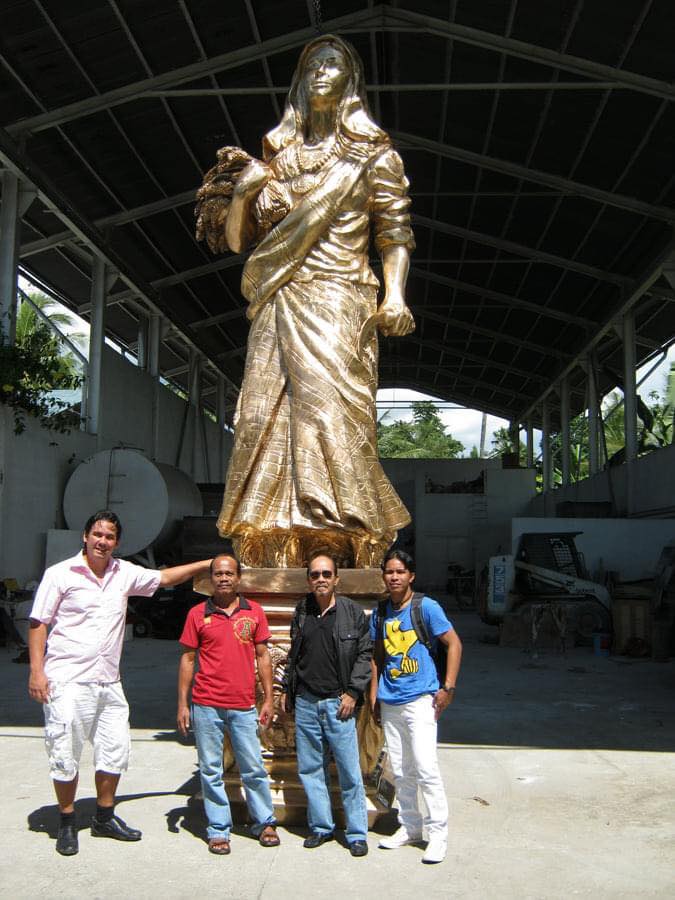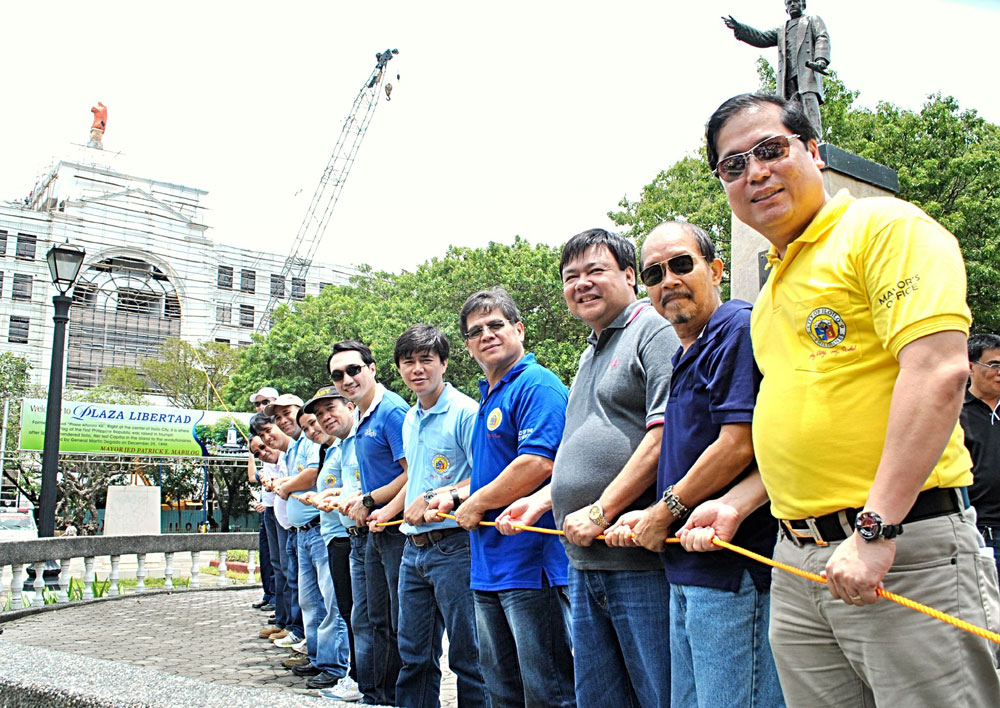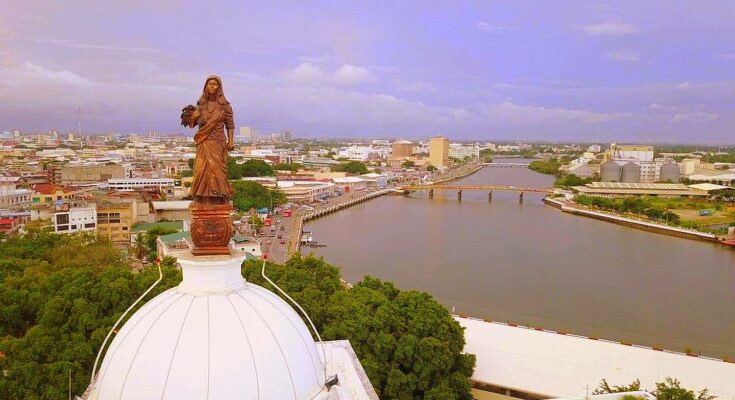Perched atop the dome of Iloilo City Hall is the “Lin-ay sang Iloilo” statue, a masterpiece of Ilonggo art icon Ed Defensor. Unveiled in 2011, the 18-foot sculpture symbolizes prosperity, rich heritage, and pride of the city and province.
In a recent post in Facebook, Defensor shared that he always get questions about the location, symbolisms, etc. of the “Lin-ay sang Ciudad de Iloilo” ever since it was installed in 2011.
“I have been besieged until now by questions, such as, “Why is it up there?”, “What is the meaning of that?”, “Why a woman, not A Datu or a hero?”, “Will there be a copy of that that we can see here on the ground, nga mapakodakan namon,” he posted.
The multi-media artist revealed that the “Lady of Freedom” at the top Capitol Building in Washington D.C., USA is the inspiration for the location of the Lin-ay. He also referred to “artistic traditions of Europe or Western countries, where hundreds of sculptures are to be found on top of domes or buildings.”
“Of course, since we are a predominantly Catholic country, many have seen the 160 gigantic marble sculptures of saints by Bernini’s disciples on top of the colonnades surrounding St. Peter’s Square. But for sure nobody usually associates them with the Lin-ay which is the only gigantic bronze sculpture on top of a building in the whole country and thus no curiosity about the Lin-ay will ever be aroused.”
“Yes, the only gigantic bronze sculpture on top of a building, and only in Iloilo City,” Defensor exclaimed.
Defensor had already explained the symbolisms of Lin-ay sang Iloilo during its unveiling on August 26, 2011. We are posting his speech in full below.
Speech By Ilonggo Arts Icon Ed Defensor during the unveiling of Lin-ay
When the good mayor, Honorable Jed Patrick E. Mabilog told me that he wanted a symbol of Iloilo on the dome of the New City Hall, the very first thing that came to my mind was that “I had dreamed of this before.”
Yes, as early as 15 years ago I already dreamed of a commission that would enable me to mold the symbol of Iloilo in brass or in bronze – the image was already clear and complete in my mind.
I dreamed of it in the same scale as it is today, but on the ground. Never did I imagine that it would be standing on the top of a dome and make history as the first of its kind in the whole Philippines.

What you see is the graceful figure of a beautiful peasant lady standing valiantly and proudly on a harvested field of rice.
I envisioned a symbol associated with our rice industry because to my mind Iloilo could not be represented otherwise since we have always been known as the rice granary of the whole Visayas, and several times in our history, of the whole country.
And to me, since our great city is the making of our great province, Iloilo therefore is both city and province. Thus, a symbol for one may as well be a symbol for the other.
What you see is a Lin-ay wearing the traditional bandana usually worn by farm ladies to protect them from the heat of the sun. On her neck she wears an ethnic necklace, symbolic of her ancestry, as she comes from a rich mythic past, from the Maragtas, the “Barter of Panay,” and the long line of heroic datus that peopled the island of Panay.
Her right arm cradles a bunch of harvested rice, symbolic of our prosperity. Her left hand holds another symbol of prosperity, the scythe or “garab” which has long been the traditional harvesting tool in the region. I remember when I was a child in the farms of Mina, Iloilo, whenever I saw a “garab,” I knew right away it is “good times” for it is harvest time.
She wears an embroidered blouse, symbolic of one of the popular traditional arts of the city and province. On top of it is a “sablay” of a “hablon,” the textile which contributed to Iloilo’s becoming the second city of the Philippines, next to Manila, at the onset of the 19th century.
The whole figure of the Lin-ay is highlighted by the “patadyong,” our native hand-woven wrap-around skirt, for which no other province is better known than Iloilo. As a bonafide historian I dare say that Iloilo has the best patadyong in the whole country.
The Lin-ay is standing on a pedestal with four sides carved with major assets of Iloilo – front shows rice-farming industry, at right is sugarcane, left is fishing industry and back depicts education since Iloilo is considered as the educational center of the Visayas and Mindanao.
Thus, I have outlined the meaning, symbolism and history of the “Lin-ay Sang Iloilo.”
I would like to thank the good mayor for his vision, love and passion for Ilonggo culture and art, for conceiving this project and making history for the city.
Consequently, I would like to thank our donor, a beautiful person who truly loves Iloilo, a philanthropist in the true sense of the word, who gives without any strings attached, who has no political ambition whatsoever, and most importantly, who does not want to be mayor and who wants to remain anonymous, unknown even to the beneficiaries of this project.
I would also like to thank the valiant workers and carpenters of the City Hall building for braving all odds, dangers and threat to life in bringing the Lin-ay up to her pedestal to stand there forever as the symbol of the greatness and pride of Iloilo. Their applause after the Lin-ay was perched will forever be embedded in my heart and memory.
Lin-ay sang Iloilo was unveiled during 74th Iloilo City Charter Day celebration on August 26, 2011.
In one of the exchanges in the social media post, Defensor acknowledged that while it should not be the ‘burden’ of artist to ‘explain’ his work especially to art critics, he is taking the cudgels by explaining its symbolisms “to the 95 per cent of Ilonggos who can not understand why a sculpture is up there on the dome of the city hall, or why should a sculpture be made for the city hall.”
“I also did it for the people who have no idea at all what the Lin-ay looked like. I don’t think that more than a hundred people saw it live before it was installed up there,” he added.

About Ed Defensor
Ed Defensor is a multi-media artist of Iloilo City, Philippines. One of the outstanding sculptors of the country, he has worked on three iconic monuments in Iloilo City: the Donato M. Pison Monument in Baranggay San Rafael, Iloilo City; the “Lin-ay Sang Iloilo”, an 18-foot monument in bronze that presently stands at the dome of the New Iloilo City Hall, the only bronze sculpture standing on top of a building in the Philippines; and the St. Ignatius of Loyola Monument of Ateneo de Iloilo, probably the biggest St. Ignatius sculpture in the whole world.
He has been doing art since the 1980s and has held exhibitions in the Philippines, New York, South Korea, and Singapore in such venues as the Cultural Center of the Philippines, Makati City, the Vargas Museum of Quezon City, the Philippine Center of New York, The Space Art Gallery of Seoul, Korea, and the Philippine Embassy of Singapore.
Defensor has had more than 15 one-man exhibitions and has participated in more than a hundred group exhibitions a number of which he himself had organized and managed.
He has been active in art management and art organizations in the Visayas group of islands in Central Philippines, having been the founder of Hubon Madiaas, the longest-existing art organization of Western Visayas, and charter chairman of the Visayas Islands Visual Artist Association, at one time one of the largest art associations of the Philippines. He has also served in the National Committee of the Visual Arts of the National Commission for Culture and the Arts. He is listed in the Encyclopedia of Philippine Arts of the Cultural Center of the Philippines in the volumes on the Visual Arts, Theater and Dance.
He was Professor of Art History at the University of the Philippines Visayas and was Most Outstanding Professional Jubilarian of this University in 2006. He has also been awarded by the Province of Iloilo in Central Philippines the title of Most Distinguished Ilonggo in the Visual Arts in 2008. In 2010, the Visayas Biennale in Cebu City, Philippines, honored him with the “Garbo sa Bisaya” (“Leading Light of the Visayas”) Award. [Photo credits: Ed Defensor, Jerry Trenas, Iloilo City Government Facebook pages]




I have nothing against the work of Art of Professor Ed Defensor but I don't see any connection with the woman in traditional patadyong with palay and garab anything to do with Iloilo City. You must remeber, that in the 1800's, Iloilo City has been one of the busiest port in the entire country because of the booming sugar industry during that time. The City is center of Industry and Education, so I don't see any connection of the present statue to Iloilo city's rich and colorful history. I prefer they erected the statue of Maria Clara with a torch to depict Iloilo City as Center of Excellence and Education or maybe Graciano lopez Jaena, a National Hero who was born in Jaro to pay tribute to this great man who contributed a lot in the propaganda movement in Spain.
Good point Jan. Daw indi naman agricultural center ang iloilo city no?
[…] http://www.iloilotoday.com/ed-defens…ilonggo-pride/ (Following are excerpts of the artist’s speech during the unveiling of Ilonggo Pride Statue, Lin-ay sang Iloilo, atop the New City Hall in celebration of 74th Charter Day August 25) […]